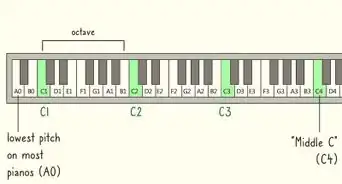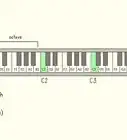This article was co-authored by Annabeth Novitzki. Annabeth Novitzki is a Private Music Teacher in Austin, Texas. She received her BFA in Vocal Performance from Carnegie Mellon University in 2004 and her Master of Music in Vocal Performance from the University of Memphis in 2012. She has been teaching music lessons since 2004.
There are 7 references cited in this article, which can be found at the bottom of the page.
wikiHow marks an article as reader-approved once it receives enough positive feedback. In this case, 92% of readers who voted found the article helpful, earning it our reader-approved status.
This article has been viewed 186,557 times.
The high tenor range, sometimes referred to as countertenor or tenor 1, is the highest male range. Singing in high tenor can be achieved by expanding your vocal range, and mastering both your chest voice and falsetto. With practice and proper technique, you can sing in high tenor, whether you’re in choir, a musical, or just for fun.
Steps
Locating Your Natural Vocal Range
-
1Learn the different vocal ranges. A vocal range is the span from the lowest to highest note that a voice can make. There are 4 main vocal ranges with several sub-ranges that people can produce.
- Every person possesses a different vocal range, and while men typically fill out the lower ranges and women the higher ranges, some people possess an ability to span several ranges.
- The 4 main vocal ranges from highest to lowest are: Soprano, Alto, Tenor, and Bass.
- Sub ranges include: Mezzo-soprano, Contralto, Countertenor, Tenor 1 or Tenor 2, and Baritone. High tenor is also known as Tenor 1.
-
2Find Middle C. Middle C is also referred to as C4 in scientific pitch notation on a music scale. Middle C will help you find your vocal range since it’s in the middle of the piano or keyboard and a great starting pitch that most people can sing.
- To locate middle C, look for the name of the piano manufacturer in the center of the piano. You’ll see a grouping of 5 black keys in the middle separated by 2 white keys. The white key directly to the left of the 2 black keys in the center of the piano is middle C.
Advertisement -
3Locate your vocal range. You can find your vocal range on a piano, keyboard, or with an app or computer program by singing along as you go up and down in the notes. To accurately find your full vocal range it’s best to do some vocal warm ups before you begin to loosen up your vocal chords.
- Start warming your voice up by humming and allow your pitch to slide up and down freely. Sing scales on lip trills by pursing your lips and blowing air through them as if you were blowing bubbles underwater.
- Start at middle C and match the pitch. Then progress downward on the piano hitting each note and matching its pitch.
- Once you’ve gone as far down as you can and still produce a sound with your voice, make your way back up and continue matching pitch to notes until you’ve gone as high as possible while sustaining the note.
- As you go higher up, you will have to sing in head voice and falsetto. Head voice is when you feel the vibrations in your head as you’re producing sound from higher up in your body. Think Mickey Mouse when trying to sing in head voice. Head voice marks the break in your voice, where you can’t smoothly hit a higher note. Falsetto, or “false voice” is when you feel that nasally pinch in the back of your throat.
- Once you’ve gone as low and high as you can, count how many octaves your voice spans. Each octave is 8 notes. Start at middle C and count down to the next C, remembering which is the lowest key you could hit. Repeat with the upper keys. Most people possess a range of 1.5 octaves.
- High Tenor is in the (G♯2-)C♯3-B4(-E5) range.
-
4Practice your tenor vocal range. If you naturally sing in the tenor range, you’re well on your way to singing in high tenor. Locate middle C again and match pitch with an "Ahhhhh" sound.
- Now locate the C an octave below Middle C, followed by the C an octave above Middle C. Match your voice to each note by going, "Ahhhhh."
- Slowly slide between the notes if you have trouble matching the pitch. Note where your throat tightens up or where you need to send more air to hit a note. Slide as far as you can without straining your voice, then back off.
- Typically the highest note for a tenor is around the E5 key.
Expanding Your Vocal Range
-
1Develop your head voice. Your head voice is like a bell. In order to master your head voice, you have to be able to access the resonance in your nasal cavity and employ your pharynx. The pharynx is the passageway that connects your nasal cavity to your larynx.
- Start in the middle of your range and produce an “Ng” sound. As you open your mouth into an “Ahhhh” sound and move up through the scale, really connect to the vibration you feel in the back of your neck.[1]
- Head voice is a connected sound, as it still involves part of your chest. So, you may not feel a break in your voice when transitioning from chest voice to head voice.
- To strengthen your head voice, sing an “Ahh” sound starting at the upper middle point in your range and sliding up until you can’t sing any higher without transitioning into falsetto.
-
2Smooth your register break. Register breaks occur when you transition from chest voice to a higher mode like head voice or falsetto. Breaks can also occur when coming back down, and can be smoothed out with proper technique and practice.[2]
- You can learn to minimize your break by opening up the throat further through manipulation of vowels. This means not pronouncing vowels as you would when speaking. Instead, draw out and round the vowel sounds to keep your larynx stable.
- Many professional singers learn to sing around the break in their voice, so don't feel like it's something you have to fix, even if you think it sounds awkward.[3]
-
3Practice your falsetto voice. Countertenors have the ability to produce a full sound in falsetto, sometimes allowing the voice to reach soprano levels. Your falsetto doesn’t resonate in your chest; it resonates in your throat, mouth, and sinus cavities.
- If you’ve ever imitated a female voice, this is similar to falsetto.
- To produce a well-rounded falsetto sound, keep your larynx stable, and picture yourself closing around the notes, not pushing or straining them outward.
- Start with the lowest note that you can in falsetto and practice scales going up and down until you can produce a consistent sound.
Singing in High Tenor
-
1Relax your body, especially your mouth and your shoulder area. They tend to be tensed when hitting high notes.
- You might be tempted to raise your chin as if you’re reaching for the note, but this will strain your voice and restrict your vocal cords. Keep your head level.
- Pull your shoulders back and align your spine in a straight line, extending through the crown of your head.
- To practice the correct posture, lie flat on your back on the floor or stand against a wall.[4]
-
2Start singing in your head voice. It will help you hit the higher notes and it should be very light sound. Project your voice from your nasal cavities.[5]
- When you sing higher notes your vocal cords get tighter and smaller, like stretching a rubber band.
- Don’t think about reaching up to hit higher notes. This will cause your voice to strain. Instead, picture reaching out farther in front of you to grab the notes.
-
3Use proper voice placement. To sing high notes without putting tension on your vocal cords, aim to use forward placement so that the sound hits the roof of your mouth first. To practice, hum and notice the gentle buzz you feel behind your nose. Press into the buzz to make your sound louder and higher. Open your mouth and imitate a siren, making sure to feel the sound in the same place in your head.[6]
- As you sing higher notes, the sound will shift toward your soft palate, but try to keep it pointed toward your nose.
-
4Open the back of your throat. Begin by singing an “Ahh” sound in your chest voice, and move up the scale. Notice how the pharynx and back of your throat feel when singing in your chest voice.[7]
- As you ascend the scale, keep your throat open and try not to let your pharynx move up in your throat.
- You’re still drawing breath from your diaphragm, but you’re not involving your nasal passages as much as you would when singing in chest voice.
- Pinch your nose and sing. Though higher notes involve your nasal cavity, you’re not singing out of your nose. Pinch your nose and transition to head voice and falsetto. Work on being able to produce a consistent sound with your nose blocked.
-
5Practice songs that have tenor 1 vocals. The best way to sing in high tenor is to practice repeatedly. By singing songs that force you to consistently hit higher notes you can begin to train your voice and expand your range. Consult a vocal coach to help you as well. Some tenor 1 songs are:
- "Alone in The Universe" from Seussical the Musical.
- "Bring Him Home" from Les Miserables.
- "The Dentist" from Little Shop of Horrors.
- "Can’t Take My Eyes Off of You" from Jersey Boys.
Community Q&A
-
QuestionWhat are the vocal warm up scales that I can do?
 Community AnswerSirens if you want to get better at high notes. Or go up the scale by half steps.
Community AnswerSirens if you want to get better at high notes. Or go up the scale by half steps. -
QuestionI'm a tenor but my voice breaks a lot while I sing. What can I do to not make it break?
 Community AnswerPractice vocal exercises that go through the parts of your voice that break. This is typically going to happen when you're working with the less developed notes of your head voice and falsetto, but can also happen at your switch from the chest. When you're singing up and down through these notes, don't tense or attack them, relax and remove as much tension from your body and singing mechanisms as possible. You will slowly develop your vocal chords until you have control of your entire range. Don't be embarrassed by a crack, just accept that it's a natural step in your vocal development. Additionally, this is extremely common when your voice is changing in puberty.
Community AnswerPractice vocal exercises that go through the parts of your voice that break. This is typically going to happen when you're working with the less developed notes of your head voice and falsetto, but can also happen at your switch from the chest. When you're singing up and down through these notes, don't tense or attack them, relax and remove as much tension from your body and singing mechanisms as possible. You will slowly develop your vocal chords until you have control of your entire range. Don't be embarrassed by a crack, just accept that it's a natural step in your vocal development. Additionally, this is extremely common when your voice is changing in puberty. -
QuestionWhat can I do to make my voice perfect?
 Community AnswerPractice. Get voice lessons. Take care of your throat.
Community AnswerPractice. Get voice lessons. Take care of your throat.
References
- ↑ https://www.youtube.com/watch?v=8B7uJg3PgPE
- ↑ https://www.youtube.com/watch?v=WWIJpEJfVcU
- ↑ https://www.nats.org/_Library/Kennedy_JOS_Files_2013/JOS-056-2-1999-027.pdf
- ↑ http://cmed.faculty.ku.edu/gummposture/posture.html
- ↑ https://www.youtube.com/watch?v=e4xomPsoSqM
- ↑ https://youtu.be/gim3aCJuUyY?t=144
- ↑ https://www.youtube.com/watch?v=p2Y_9PK438Y
About This Article
To sing high tenor, try to relax your chin and shoulders as you sing, since this helps expand your vocal cords. Once you're ready to start singing, use your head voice by projecting your voice through your nasal cavities as this creates a higher pitch. Additionally, try to use forward placement by directing your voice towards your nose so the sound hits the roof of your mouth. Then, practice songs with tenor 1 vocals like "Alone in the Universe" from Seussical the Musical, which will help you train your voice. For tips on how to locate your vocal range and how to practice your falsetto voice, keep reading!





































































